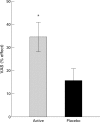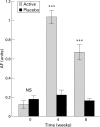Food induced stimulation of the antisecretory factor can improve symptoms in human inflammatory bowel disease: a study of a concept
- PMID: 10807895
- PMCID: PMC1756448
- DOI: 10.1136/gut.46.6.824
Food induced stimulation of the antisecretory factor can improve symptoms in human inflammatory bowel disease: a study of a concept
Abstract
Background: Antisecretory factor (AF), a 41 kDa cloned and sequenced protein, suppresses intestinal inflammation and hypersecretion in animals. Endogenous AF production can be induced by dietary modifications in several animal species, and this feed has been shown to reduce the incidence of diarrhoeal disease in weaning piglets. The role of AF in intestinal disease in humans is not known.
Aims: To study the effects of hydrothermally processed cereals, optimised for AF induction in animals, added to the diet of patients with longstanding symptoms of inflammatory bowel disease (IBD).
Patients: Fifty three patients with IBD (ulcerative colitis and Crohn's disease) were entered into the study, and 50 completed follow up. The experimental group consisted of 16 females (mean age 50 (SEM 5) years) and 10 males (41 (4) years) and the placebo group of 12 women (41 (4) years old) and 12 men (51 (5) years).
Methods: Patients were randomised to receive either hydrothermally processed cereals (active treatment) or the same amount of ordinary cereals (placebo treatment) for four weeks in a double blind study design. Baseline diet and medications remained unchanged. Bowel symptoms, plasma levels of AF, and colonic biopsies were evaluated before and after treatment.
Results: The active treatment significantly improved subjective ratings of clinical symptoms and increased plasma AF levels compared with placebo. Plasma lipid levels were unaffected.
Conclusion: Hydrothermally processed cereals can induce AF production in human IBD. This increase in endogenous AF activity is associated with clinical improvement. Further studies are warranted to clarify the exact role of AF in human intestinal disease.
Figures




References
Publication types
MeSH terms
Substances
LinkOut - more resources
Full Text Sources
Other Literature Sources
Medical
